
Chim at work. Rome, circa 1956.
Photograph by Judith Friedberg.
�1996 Judith Friedberg
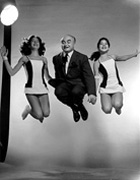
Chim with Irene and Jane Halsman, daughters of Philippe Halsman. New York City, 1955.
Photograph by Philippe Halsman.
�1996 from the Estate of Philippe Halsman
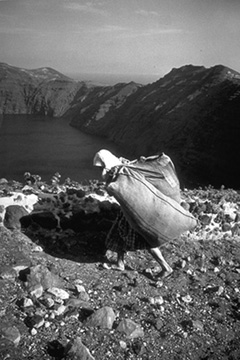
The Island of Santorini, 1951
�1996 from the Estate of David Seymour
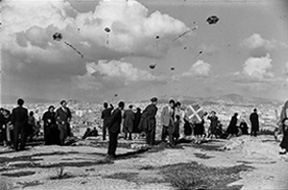
Kites. Athens, 1954
�1996 from the Estate of David Seymour
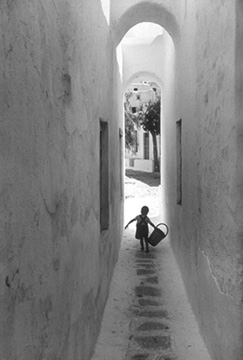
Mykonos, Greece 1951
�1996 from the Estate of David Seymour
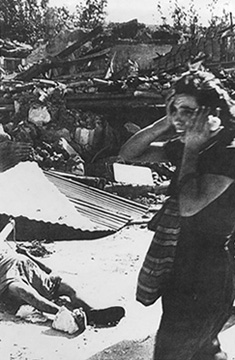
The worst earthquake of modern Greek history. Zante, 1953
�1996 from the Estate of David Seymour
|
Chim was passionately interested in contemporary social and
political developments, but part of him yearned for the ancient, for
the aesthetic. He began stopping in Greece on his way to Israel. It
was the warmth of the Greek people as well as the beauty of the land
that attracted Chim when he first visited Greece in 1948, while the
country was still in the throes of civil war. But soon, returning to
Greece became a ritual. Ahead of the tourist crowds, Chim explored
the Grecian isles, and later its places of antiquity. As a scholar, these
places stirred his imagination and evoked a lyricism rarely seen in his
work. He wrote to his sister: "It is really a sort of escape from the
world in which we are living, to wander through the ancient Greek
ruins and to sail around the islands. One gets philosophical looking at
the remnants of great civilizations, and there is another advance to
being in Greece... there is no way to read the papers. Outside Athens,
the isolation is perfect and wonderful."
The day of Chim's audience with Queen Frederika, the worst
earthquake of modern Greek history befell the fabled Ionian islands
of Cephalonia, Zante, and Ithaca. The royal family immediately
canceled all appointments and rushed to the scene of the
catastrophe and so did Chim, separately.
The tremors continued for a week. Of the island's 118,000
inhabitants, one thousand were estimated to have been killed, ten
times that number wounded, and most of the residents left without
homes. Within days, a six-nation rescue operation moved into gear,
supplying food, water, and shelter, and evacuating the injured to the
mainland. Chim photographed the devastation, as utter and shocking
as any ancient Greek tragedy, and the pregnant woman in the rubble
remains his most powerful photograph. He wrote: "If one believed
in anything, it would be the solidity of the ground on which we stand,
and if that starts to jump what can we trust?"
Later, the Queen returned from the Red Cross mission
during which Chim had photographed her comforting the injured and
bereaved and inspecting the Red Cross installations for newborn
babies. She again agreed to pose for Chim, this time in full regalia,
adorned by her priceless emerald jewelry. It became the cover story
of Jours de France later that year.
Always fascinated by religious institutions, Chim visited the
miraculously beautiful valley of meteors, where a score of Greek
Orthodox monasteries are perched atop huge, steep, mountain-like
rocks. No female animals or women are allowed in these
monasteries, and access to provisions is by basket lowered by rope.
The monasteries are ideal for a different kind of escape from the
world: hardly a visitor is allowed to interrupt the contemplation of
the monks. Much like his work on Israel, Chim's exploration of Greece
was really just beginning in earnest at the time of his death he
would have undoubtedly continued to build upon this body of work in
future trips.
While Chim was photographing in Greece, in Israel, in Italy, in
France, and in England, thoughts of Magnum were always with him.
In fall 1955, at the annual stockholders meeting, Chim made a
convincing case for expanding the membership: thirteen
photographers who had been working with Magnum for some time
were offered stock options, to be exercised by the 1956 meeting.
Chim spent a good part of the following year laying out all the
accouterments of a corporation. While setting up the Magnum house,
Chim settled himself for the first time in his life into a regular home in
Rome. Since World War II, he had lived in modest hotel rooms. In the
summer of 1956, he moved into a small apartment on the top floor of
the Palazzo Orsini. Appropriately steeped in history, it had been the
birthplace of a pope. But it now marked the last chapter in Chim's
own life.
- Inge Bondi
� 1996, Inge Bondi
from CHIM: The Photographs of David Seymour, Bulfinch Press/Little, Brown and Company
|





































